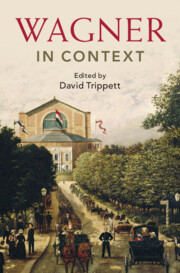Book contents
- Wagner in Context
- Composers in Context
- Wagner in Context
- Copyright page
- Contents
- Illustrations
- Musical Examples
- Contributors
- Acknowledgements
- Abbreviations
- Introduction
- I Place
- II People
- III Politics, Ideas, and Bodies
- Chapter 15 National Politics
- Chapter 16 Revolutionary Politics
- Chapter 17 World-Drama: Wagner’s Hegelian Heritage
- Chapter 18 Towards an ‘Ideal’ Feminine
- Chapter 19 Health and Wellness
- Chapter 20 Sexuality and Social Mores
- Chapter 21 Sentient Bodies
- Chapter 22 Racial Theory
- IV Life, Language, and the Ancient World
- V Music and Performance
- VI Reception
- Further Reading
- Select Bibliography
- Index
Chapter 16 - Revolutionary Politics
from III - Politics, Ideas, and Bodies
Published online by Cambridge University Press: 14 March 2024
- Wagner in Context
- Composers in Context
- Wagner in Context
- Copyright page
- Contents
- Illustrations
- Musical Examples
- Contributors
- Acknowledgements
- Abbreviations
- Introduction
- I Place
- II People
- III Politics, Ideas, and Bodies
- Chapter 15 National Politics
- Chapter 16 Revolutionary Politics
- Chapter 17 World-Drama: Wagner’s Hegelian Heritage
- Chapter 18 Towards an ‘Ideal’ Feminine
- Chapter 19 Health and Wellness
- Chapter 20 Sexuality and Social Mores
- Chapter 21 Sentient Bodies
- Chapter 22 Racial Theory
- IV Life, Language, and the Ancient World
- V Music and Performance
- VI Reception
- Further Reading
- Select Bibliography
- Index
Summary
This chapter addresses the political and intellectual context for Wagner’s revolutionary socialism. The nineteenth century stood in the light and shadow of the French Revolution, emboldened and fated to revisit and to relive many of its questions and practices. Wagner’s life mixed revolutionary theory and practice: in the Dresden uprising of 1849, but also in its ‘Vormärz’ prologue and in its apparently counter-revolutionary aftermath. Wagner experienced revolution on at least three geographical levels, European, German, and Saxon, the third receiving particular attention here. The focus is on Wagner’s most unambiguously revolutionary period, the 1840s and early 1850s, yet these ideas continued to play out in life, thought, and dramatic oeuvre: not only until completion of the Ring in 1874, Wagner’s revolutionary ‘fire cure’ reaching fulfilment in the final conflagration of Götterdämmerung, but in Parsifal and beyond. Earlier themes did not go unchanged; they provided shifting foundations for further dramatic exploration.
- Type
- Chapter
- Information
- Wagner in Context , pp. 159 - 167Publisher: Cambridge University PressPrint publication year: 2024

